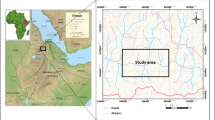Summary
The 7,700-km2-area Federal Capital Territory, Nigeria, is underlain by crystalline igneous and metamorphic rocks of Precambrian age. Sandstone and claystone of Cretaceous age overlie Precambrian rocks in the southwestern part of the Territory. Laterite caps many hills of Cretaceous rock, some hills of Precambrian rock, and crops out near stream banks in the east and northeast. The most conspicuous structural features are a broad “J”-shaped fold traversing the eastern and central part of the Territory and a north-trending shear zone along the eastern boundary. The soils of the Territory are lateritic and belong to the SW-SP-SM (Unified Soil Classification System) groups covering Precambrian migmatites gneisses and granites and the SC group covering Cretaceous sediments and Precambrian mica-rich schists. The average penetrometer shear strength of the soil is 3.11 bars. The engineering characteristics of the rocks are (1) medium- to high-strength massive and gneissic rock, (2) low-to medium-strength bedded rock, and (3) low-strength foliated and sheared rock. An area of at least 800 km2 is free from apparent geological hazards and should be suitable for construction of a capital city, its environs and supporting facilities.
Résumé
Le territoire de la capitale fédérale du Nigéria, d'une superficie de 7 700 km2, est formée de rochescristallines ignées et métamorphiques d'âge Précambrien, recouvertes dans la partie Sud-Ouest du territoire par des grès et des argilites d'âge Crétacé. Des formations latéritiques, affleurent le long des ruisseaux à l'Est et au Nord-Est, coiffent de nombreuses collines de roches d'âge Crétacé et quelques collines de roches d'âge Précambrien. Les traits structuraux les plus marquants sont un large plissement en forme de «J» traversant la partie Est et et centrale du Territoire et une zone de cisaillement de direction Nord à la limite Est du territoire. Les sols de constitution latéritique, appartiennent aux groupe SW-SP-SM (Unified Soil Classification System) lorsqu'elles recouvrent les granites, les gneiss et les migmatites d'âge Précambrien et au groupe SC lorsqu'elles recouvrent les roches sédimentaires d'âge Crétacé et les schistes riches en micas d'âge Précambrien. Leur résistance moyenne au cisaillement, mesurée au pénétromètre, est de 3,11 bars. Les caractéristiques géotechniques des roches sont: (1) roches massives et gneissifiées de résistance moyenne à haute, (2) roches litées de résistance basse à moyenne, (3) roches en feuillets et cisaillées de basse résistance. Une superficie d'au moins 80 km2 ne présente aucun danger géotechnique, et la construction de la capitale, de ses environs ainsi que de ses infrastructures, s'y avère adéquate.
Similar content being viewed by others
References
ADELEYE D.R. and DESSAUVAGIE T.F.J. (1972): Stratigraphy of the Niger Embayment near Bida, Nigeria,in Dessauvagie, T.F.J. and Whiteman, A.J. editors, African Geology. University of Ibadan, Conference on African Geology, Proceedings, p. 181–186.
DEERE D.U. and MILLER R.P. (1966): Engineering classification and index properties for intact rock. U.S. Air Force Weapons Laboratory Technical Report, AFWL-TR-116. Available from Customer Services, Clearinghouse, U.S. Department of Commerce, Springfield, Virginia, USA, as report number AD 646 610.
EGE J.R., MILLER D.R. and DANILCHIK Walter (1970): Schmidt hammer test method for field determination of physical properties of zeolitized tuff. U.S. Geological Survey Open-file Report 1490, 40 p. Available from Branch of Distribution, U.S. Geological Survey, 1200 South Eads Street, Arlington, Virginia, 22202, USA.
EGE J.R., GRIFFITTS W.R. and OVERSTREET W.C. (1977): Preliminary engineering geologic report on selection of urban sites in the Federal Capital Territory, Nigeria, U.S. Geological Survey Open-file Report 77-885, 78 p. Available from Branch of Distribution, U.S. Geological Survey, 1200 South Eads Street, Arlington, Virginia, 22202, USA.
FEDERAL CAPITAL DEVELOPMENT AUTHORITY (1977a): LANDSAT-image geographic map, Federal Capital Territory, Republic of Nigeria Federal Capital Development Authority, LANDSAT Image Map, scale 1:100,000.
FEDERAL CAPITAL DEVELOPMENT AUTHORITY (1977b): Provisonal map showing land use based on the interpretation of vegetation, Federal Capital Territory, Republic of Nigeria. Nigerian Federal Capital Development Authority, LANDSAT Image Map, scale 1:100,000.
GIDIGASU M.D. (1976): Laterite soil engineering. Amsterdam, Elsevier Scientific Publishing Company, 554 pp.
NETTING R.M. (1968). Hill farmers of Nigeria. Seattle, Washington, University of Washington Press, 259 p.
PETERSON L.R. and MEYER Gerald (1977): Hydrologic reconnaissance evaluation of the Federal Capital Territory and surrounding areas, Nigeria. U.S. Geological Survey Open-file Report 77-596, 30 p. Available from Branch of Distribution, U.S. Geological Survey, 1200 South Eads Street, Arlington, Virginia, 22202, USA.
RACKAM L.J. (1972): The planation surfaces of a part of the basement complex of northern Nigeria-an interim report,in Dessauvagie T.F.J. and Whiteman A.J., editors, African Geology: University of Ibadan, Conference on African Geology, Proceedings, p. 427–535.
UNITED NATIONS DISASTER RELIEF CO-ORDINATOR (1980): Natural disasters and vulnerability analysis. Geneva, Office of the United Nations Disaster Relief Co-ordinator (UNDRO), 49 p.
U.S. BUREAU OF RECLAMATION (1974): Earth manual. Superintendent of Documents, U.S. Government Printing Office, Washington, D.C., 20402, 810 p.
Author information
Authors and Affiliations
Rights and permissions
About this article
Cite this article
Ege, J.R., Griffitts, W.R. & Overstreet, W.C. Engineering-geology site appraisal of the Federal Capital Territory, Nigeria. Bulletin of the International Association of Engineering Geology 31, 71–79 (1985). https://doi.org/10.1007/BF02594749
Published:
Issue Date:
DOI: https://doi.org/10.1007/BF02594749




